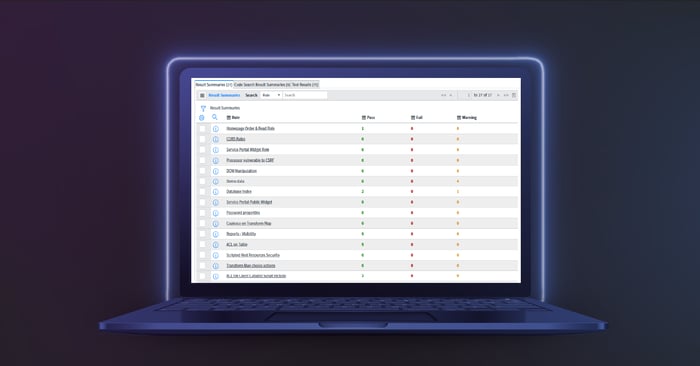HFS Research Podcast: The Next Wave with Bill...
Bill McDermott (Chairman and CEO of ServiceNow) and Ravi Kumar (CEO of Cognizant) join HFS Research Chief Analyst Phil Fersht to explore how AI is revolutionising enterprise...
Read MoreThirdera generates transformation, digitisation, and automation for our customers at the speed of NOW.
We help organisations adopt better patterns of work and get more from ServiceNow. Our team unlocks enterprise potential to elevate experiences across the world of work.
We help organisations adopt better patterns of work and get more from ServiceNow. Our team unlocks enterprise potential to elevate experiences across the world of work.
We help organisations adopt better patterns of work and get more from ServiceNow. Our team unlocks enterprise potential to elevate experiences across the world of work.
We help organisations adopt better patterns of work and get more from ServiceNow. Our team unlocks enterprise potential to elevate experiences across the world of work.
We help organisations adopt better patterns of work and get more from ServiceNow. Our team unlocks enterprise potential to elevate experiences across the world of work.
We help organisations adopt better patterns of work and get more from ServiceNow. Our team unlocks enterprise potential to elevate experiences across the world of work.
We help organisations adopt better patterns of work and get more from ServiceNow. Our team unlocks enterprise potential to elevate experiences across the world of work.
We help organisations adopt better patterns of work and get more from ServiceNow. Our team unlocks enterprise potential to elevate experiences across the world of work.

.jpg?width=500&height=276&name=filter%20group%20of%20people%20at%20desk%20laptop%20laughing%202021-10%20(1).jpg)


Insurance Provider Projects $75MM Gain in Business Value from Asset Management Transformation
Read more
.jpg?width=500&height=276&name=Multichannel%20pipette%20tips%20reaction%20mixture%20plastic%20wells%202022-05%20(1).jpg)
.jpg?width=500&height=276&name=group%20-%20statistical%20analysis%202023-03%20yellow%20pink%20(1).jpg)
Balancing mission-driven goals with operational efficiency requires innovative solutions that can streamline processes and enhance programme delivery without straining budgets.

UN Agencies Rely on Thirdera and ServiceNow to Support the Ukrainian Aid Response
Read moreDigitise and automate workflows to enhance the customer experience, online and in-store.

.jpg?width=500&height=276&name=Servers%20data%20center%20room%20with%20bright%20speed%20light%202022-05%20(3).jpg)
Global SAP on Cloud Leader, Lemongrass, Embarks on Multi-Continent ITSM Overhaul
Read more

Stay up to date with the insights from ServiceNow experts and explore our blogs, news, case studies culture posts, partner updates and more.
Stay up to date with the insights from ServiceNow experts and explore our blogs, news, case studies culture posts, partner updates and more.
.png?width=500&height=276&name=MicrosoftTeams-image%20(638).png)
Stay up to date with the insights from ServiceNow experts and explore our blogs, news, case studies culture posts, partner updates and more.
.png?width=500&height=276&name=MicrosoftTeams-image%20(638).png)
Stay up to date with the insights from ServiceNow experts and explore our blogs, news, case studies culture posts, partner updates and more.
.png?width=500&height=276&name=MicrosoftTeams-image%20(638).png)
Stay up to date with the insights from ServiceNow experts and explore our blogs, news, case studies culture posts, partner updates and more.
.png?width=500&height=276&name=MicrosoftTeams-image%20(638).png)
Stay up to date with the insights from ServiceNow experts and explore our blogs, news, case studies culture posts, partner updates and more.
.png?width=500&height=276&name=MicrosoftTeams-image%20(638).png)
Stay up to date with the insights from ServiceNow experts and explore our blogs, news, case studies culture posts, partner updates and more.
.png?width=500&height=276&name=MicrosoftTeams-image%20(638).png)

In Part 1 of our blog series on developing apps for the ServiceNow Store we discussed some tips for situations where/when the Store can benefit your application, how to design your app, and tools that might help. Just catching up? Click here for a review of Part 1.
To many would-be application developers, one of the most valuable features of ServiceNow Store apps can also be one of its most intimidating: certification. Many coders and businesses might ask questions such as what types of requirements does my application need to meet in order to pass certification? Does my idea have enough merit to survive certification? Or, how can I best prepare to ensure certification doesn’t take months? These are just some of the questions we’ll seek to answer here, but rest assured that you are not alone in your concerns! Just keep this in mind – certifiers are not devilish programmers out to point out coding mistakes and question your abilities, nor is it an unresponsive robotic wall that intends to put frustration between your app and publishing. The certification team exists to help ensure ideas are well-executed and adhere to best practices on the platform.
In their App Store guidelines, Apple used to have a section regarding app certification that said, “This is not amateur hour.” At an initial glance that may appear harsh, but bear in mind the prerogative is ultimately to give customers confidence that the applications available through their Store are well-tested, highly performant, and effective solutions to real customer problems. When taking your idea from good to great, adding security, performance, and robustness are paramount, and feedback from the certification team will help you walk that path.
First, before we even get into how to submit an app for certification, let’s discuss some ways that you can prepare your app. For starters, build a professional app and take advantage of many different platform features where applicable. Include reports and dashboards. Use table inheritance where possible to inherit existing features rather than recreating them. If an integration point for third-parties exists, use it rather than create a one-off solution. Ensure your code is well-documented and organised; ideally, something you’d be proud to hand to a computer science professor. And make sure you have reviewed ServiceNow best practices for development such as Community threads like this or ServiceNow Developer Site content. The better coded your app is, to begin with, the fewer interactions you’ll need with the certification team.
Another important tool to ready your application is called the “Certification Self-Test Tool”, and it is available in the platform application list. Note: This app will only be available on vendor instances obtained by those who have registered for the ServiceNow Technology Partner Program – you remembered that from Part 1, right? This importantly means you won’t be developing Store apps on your free dev instances. Open up the “System Applications” module and search for “Certification”:
-1.png?width=1910&name=MicrosoftTeams-image%20(5)-1.png)
Image 1: Install the Certification Self-Test Tool
Once the “Certification Self-Test Tool” app is installed, you’ll find a new button on your applications labelled “Validate Application”. Clicking this button will trigger a set of tests very similar to the initial tests a certifier will run on your application, giving you a quick review of findings that may affect your certification. Different categories of tests will be grouped into the pass, fail, and warnings (see Image 2 below). Drill in on any issues and figure out how you can correct them before you submit. These could be simple best practices such as making sure your REST calls are asynchronous, including ACLs for your client-callable script includes, or making sure there are roles on your application modules and UI actions. The issues will include links and/or sys_ids for the records and application files affected. Make sure you address them all as it will make a large difference in how quickly you can get through certification.

Image 2: We want to see all "0" in the Fail column
Another bit of prep is combing through your application for any artifacts that you don’t want to include in the Store and ensuring it is clean and ready to download. Here are a few quick checks that you may find useful:
Finally, the certification team has three documentation templates available to help structure your efforts and communicate with the team. Before submitting the app, we want to prep this material ahead of time. These documents can be found in the TPP portal or requested through ServiceNow. Pro-tip: You’ll find advantages to being thorough with the ServiceNow documents as much of the material will help with end-user-facing user/admin guides you’ll want to write later on.
All three of these documents will be required for certification submission, so preparation ahead of time will speed up the process.
Check back for the final installation (Part 3) in this series where I'll detail how to submit your app to the ServiceNow Store.
At Thirdera, we’ve built more certified ServiceNow apps than any other ServiceNow partner. Let our experience help turn your app from idea to asset on the ServiceNow Store!
Bill McDermott (Chairman and CEO of ServiceNow) and Ravi Kumar (CEO of Cognizant) join HFS Research Chief Analyst Phil Fersht to explore how AI is revolutionising enterprise...
Read MoreAs artificial intelligence (AI) and machine learning (ML) continue to transform entire industries, organisations increasingly need robust governance and visibility into these...
Read MoreArtificial intelligence (AI) is changing how we interact with technology, driving improvements in business processes and customer experiences. Two of the most talked about...
Read MoreOriginally introduced in ServiceNow Utah, Application Portfolio Management (APM) was a part of the Strategic Portfolio Management (SPM) toolset. APM offered the capability to...
Read More